#heroes and history makers event
Text

*NEW* Adam Driver photographed attending the ‘Heroes & History Makers’ event, 11th October 2023
-heyerinscanlon via @adamdrivercentl on Twitter
47 notes
·
View notes
Note
Hello! Sorry if I'm asking this in the wrong place, but I would really love to hear your thoughts on this matter! Am I wrong in being confused as to what parts of Hercules are supposed to have inspired the plot in Book 6? For most of the other books, I feel like there were clear parallels to the movies, but despite having watched Hercules a dozen times over, I still don't see it. That may be because I play EN and we haven't gotten to see any movie-inspired parts yet, or maybe because I just didn't notice the parts that were!


Episode 6 is definitely the biggest departure from its Disney counterpart. Unlike previous installments of the main story, we don’t see major similarities in the plot until later in 6. (I’m keeping this description vague to avoid spoilers for the latter half.) Even then, some of the episode 6 parallels are things you need to actively think about, or there are roles that get swapped around; they are not explicitly spelled out or 1:1 exact parallels unlike “OOoOooOh, you have THREE days to fulfill your end of the contract with me, the evil octopus deal maker” or, “this is Ruggie and he will be a stand-in for the hyenas that do Scar’s dirty work and set the stampede off”.
One thing I will say is that a major conflict or theme in episode 6 is moreso connected to the titular Hercules than to Hades. We kind of already got hints of it through Idia’s dialogue in which he expresses no hope for his future; we’ll get more of it later (and while I’m not sure how the localization will translate it, JP pretty much references “going from zero to hero”, referring to Idia’s situation, in a variety of ways). In the Ignihyde CM, we have another clear reference to Hercules with Ortho (the speaker) telling Idia that he can “go the distance”:

At other times, it’s more like 6 borrows heavily from Hercules lore rather than directly copies events for its plot. For example, the background for the Shroud family and how they came to oversee Styx is extremely similar to the history of Zeus locking away the Titans and/or Hades leading an uprising against Zeus. Twisted Wonderland also has the Phantoms in place of the souls of the dead, which Idia (Hades) oversees.
This may be just me, but I like that 6 is so different from the other chapters; since the parallels aren’t as obvious, it makes it much harder to predict what’s going to happen and encourages discussion about what exactly the parallels are.
#Idia Shroud#Ortho Shroud#Ruggie Bucchi#Azul Ashengrotto#Ignihyde#notes from the writing raven#question#Hercules#Hades
87 notes
·
View notes
Note
I'm a massive MM fan, and I'm curious what the Demon Tribes AU is about, like the sparknotes version, because from what I've seen on this blog it looks rad as hell
Hi there! Thank you for your ask.
The AU itself is a combination of Majora's Mask and Skyward Sword lore. It presents the idea that the ancient, war-prone Ikanan Kingdom is one in the same with the Demon Tribes of Skyward Sword's prologue which caused the Ancient War. The resulting world is an ancient version of Termina, back when the continent was ruled entirely by Ikana.
As for the story aspect underneath the AU's umbrella, that is called The Mask-Maker and will include subsequent future works. TMM is about Link struggling with his identity as a hero two years after the events of Skyward Sword. There, he suffers from recurring, seemingly-prophetic nightmares about his death at the hands of a demon from Ikana. During unrelated events, he eventually finds his way to the kingdom while in the company of Ghirahim, who turns out to also have ties to the region. Link's adventure in Ikana is to confront the demon which haunts him, but he ends up finding out way more about the history of the Ancient War, what demons are actually like, and what his role in all of this is. This story also includes eventual exploration of prior characters from both SkSw and MM such as Batreaux, Zelda, Groose, Majora, and the Fierce Deity. There are also many OCs involved in order to flesh out the world further.
Please note that there is a ship involved in the story - the ship is Ghirahim/Link with the two now being aged 22/20 respectively. The bulk of the story is focused on the adventure and worldbuilding within Ikana, and the romance content is secondary. It is not an explicit work but is rated M due to occasionally suggestive content. I say this so that you can make an informed decision on whether you want to engage with work that involves a ship.
Thank you again for your ask and I hope that answers your question.
26 notes
·
View notes
Text
Not to agree with Tevinter but I'm deeply committed to "Andraste was a regular human mage" as a lifestyle because I think it's a better story. Also I see her as kind of the "player character" of her time, the same way Javik was the Shepard of his time with his own crew and mission etc. A regular woman caught in events beyond herself and having to become a leader. A hero's journey. Confirming the existence of the Maker either way would be silly imo and I would hate soooo much for Andraste to be Mythal and Solas to be Shartan or anything like that. First there can be more than one bald elf in all of history and Solas was havin a little nap anyway supposedly. Can't it just be a Normal Elf who did something important? Making everything about the Evanuris is boring, I'd rather it just be an ordinary tale about ordinary people that did extraordinary things and were eventually warped into legend and then religion.
#i WOULD accept Flemythal being involved but as a side character. because that's what she does#imo the wife of archon hessarian would fit her better like i said#but even just as herself#dragon age#andraste#i feel like there's some weight to the solas is shartan theory unfortunately#andraste and shartan: we're just normal men. we're just innocent men.
15 notes
·
View notes
Text
MALMAISON MEDIA SALON SOIRÉE 19: LA MÁSCARA NEGRA(1982)
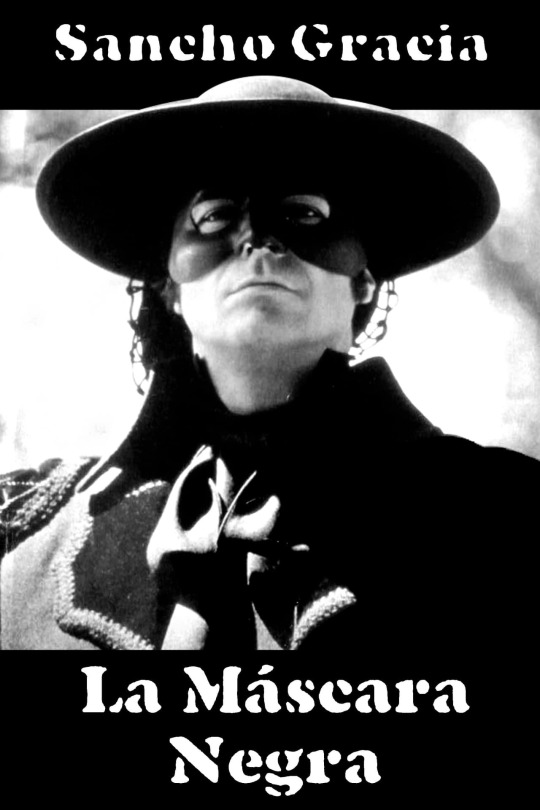
1. The Introduction
Greetings, Neighbors. I missed you and hopefully you missed me too!
Anyway, you already know that I kept rescheduling because a lot of stuff has happened, so let’s not waste time on explanations and talk about this obscure swashbuckling TV series made in Spain in 1982.
I found it on IMDb a while ago, under the category of Napoleonic movies and series. Since I have a soft spot for swashbuckling stories and hadn’t seen anything of the genre set during Peninsular War, you can imagine how curious I got.
Luckily, the entire 11 episodes can be found on YouTube, but only in Spanish so yeah… it’s a bit of a bummer, unfortunately.
Either way, I do speak Spanish fairly well, so at the very least I can make a review out of the series! Let’s see if it’s actually an interesting subject. Also, this review is dedicated to @josefavomjaaga , @that-enragee and @koda-friedrich .
2. The Summary
Obviously, the classic swashbuckling formula with a masked hero definitely applies here. Our protagonist is one Don Carlos de Zaráte, an adventurer who returns to Madrid right before the beginning of the Peninsular War.
Although reluctantly, Don Carlos eventually assumes the identity of The Black Mask, a folk hero fighting the French and their collaborators, all while pretending to be a collaborator himself by day.
3. The Story
The swashbuckling genre in its classic form isn’t exactly known for that much originality, but, as someone who grew up on such stories, I don’t actually mind the classic formula, as long as the story and characters still appeal to me.
Luckily, here the story has a twist: Don Carlos is not the original Black Mask, but rather he assumes the mantle of the hero at the beginning of the story, succeeding the person who had the alter ego beforehand.
And at first Don Carlos is reluctant to do it until he decides to fight the French invaders, which makes room for some nuance in the story and the character arc. The show could have benefited from having nuance in the French characters too, but usually swashbuckling stories don’t have the most complex villains so there’s that.
I did like the pacing, the semi-episodic story structure and a bit of an ambiguous ending that still neatly wrapped up the plot.
Also, I find it refreshing that many historical events are a backdrop for the actual plot, unlike all the stories I’ve seen where characters help shape history (nothing wrong with either btw).
4. The Characters
Don Carlos is actually a pretty complex character. Instead of merely pretending to be a foppish aristocrat, he actually used to be one before the story and only during the series it becomes merely a facade to ward off suspicions. He grows and matures a lot over the course of the story while still remaining the same person at his core, so the change feels realistic.
He’s also very cunning and ingenious, using various tricks to aid him in his escapades. Not above seduction or gambling, but, again, often uses it to maintain cover and gather information.
Then there’s Elodia, a young hat maker who Don Carlos takes under his wing. While she is too young to help The Black Mask, sometimes she does have an important role in the adventures and she also has a found family kind of dynamic with Don Carlos, which is sweet! She is very mature, but still a realistically written child.
Don Diego, younger brother of Don Carlos, is a much more hotheaded and idealistic youth than his brother and his role, while quite small, still sets the main events in motion.
Francisco Goya, who is basically a minor recurring character, stays neutral (at least publicly) but in reality is appalled by the war and isn’t afraid to speak through his art, even though it’s still very dangerous. He even plays a prominent role in one of the episodes.
Joachim Murat, who makes a few appearances, surprisingly isn’t made stupid! Sure, he is very ruthless, but at the very least he’s smart.
Joseph Bonaparte is name dropped and at least one character calls him a drunkard, but not Pepe Botellas.
Soult is mentioned as well but doesn’t appear in the series.
5. The Setting
Actually I like the setting. Not very high budget but still quite nice and seems accurate enough, at least to me.
I especially liked all the landscapes like hills, the shores, etc.
6. The Acting
Amazing job all around, especially when it comes to Sancho Gracia, who plays Don Carlos. This particular actor actually appeared in a lot of media set during peninsular war. A few actors are a bit too old though, like the one who played Murat.
7. The Conclusion
Honestly, I did enjoy the series! Flaws aside, it’s a pretty solid adventure story with an interesting twist on the usual masked avenger formula so, if you do know Spanish and are looking for a fun series to kill time, I recommend it!
Anyway, that would be all for today’s soirée. Thank you for coming and stay tuned for more reviews!
Love,
Citizen Green Pixel
#malmaison media salon#la mascara negra#peninsular war#joachim murat#napoleon bonaparte#joseph bonaparte#francisco goya#jean de dieu soult
13 notes
·
View notes
Text
Here's part 2 of my previous Ufrajozlen post!
Nimeghoruka (plural noun: Nimeghorukas):
The Nimeghorukas are the most ancient tribal breed, predating all of the others by thousands of years. Due to this, they are viewed as a very knowledgeable folk who clearly understand the ways of motherly earth and its temperamental nature. They have passed down their wisdom and skills to their own generations as well as the other Ufrajozlen tribal breeds. They all respect the Nimeghorukas, carefully making sure that they don’t overstep the boundaries of their established treaties and ruining their protected territories. Their long, thick hair is often braided and is never cut as they see it as extensions of the earth and their spiritual identity. They either have limestone, sienna or chestnut skin and wear items of clothing made from animal skin and indestructible silk or durable sinew. They are often decorated with mesmerising embroidery and their dyed colours from flowers, fruits, roots and berries. They also wear homemade jewellery and elaborate headdresses that always contain feathery elements. They have the ability to sense emotions, communicate with the earth, shapeshift with the use of pelts, and clearly mimic the sounds of animals and the voices of other people. Their tribal roles are that of careful hunters and fishers, physicians who hold professional knowledge on various medicines, remedies and beneficial flora, and nature guides that respect and try to preserve the earth. They prefer to live in forests where nature is plentiful and near swamps, and their architecture is a fusion between Mesoamerican and Ancient Egyptian.
Skjezulofima:
The Skjezulofima is the second known tribal breed that’s considered to be quite ancient. Originally, they heavily relied on the wisdom and skills that were given to them by the Nimeghorukas. Overtime, they departed from their hunter-gatherer and trading past into a more scribe-based, law-making society. When this change occurred, they decided to repay the Nimeghorukas with various gifts such as gemstones, fur pelts, and empty scrolls. The Skjezulofima did this out of respect and wanted to send a message that they’re truly grateful for their help over the years. After a few historic events, they established various laws and even treaties that all Ufrajozlen tribal breeds still rely on till this day. They’re born with snow-white skin and partially long hair of varying blonde or red shades. They prefer to wear elegant robes that cover most of their figure as modesty and professionalism is an important aspect of their culture. They also wear jewellery on their ears and fingers, and embroidered shawls that contain a symbol relating to their family. Their abilities consist of withholding an infinite amount of knowledge, mind-reading, levitating lighter objects (e.g. books), and telepathy. Their tribal roles are that of studious scholars, unbiased law-makers and judges, and respectful record-keepers who try to perfectly preserve all history. They often live amongst meadows where there is a perfect amount of space for farming land, and their architecture is similar to Classical and English Gothic styles.
Mikhazlofendus:
The Mikhazlofendus are the third known ancient tribal breed that were originally a part of the Skjezulofima. The main reason why they splintered off and became their own tribal breed is because of a heated dispute and the grandiose delusions of their first leader. This led to a devastating war that lasted for many years until their leader was brutally murdered by a legendary Drakuzlogen hero. This is one of the reasons why the Skjezulofima were quick to establish various treaties and laws in order to maintain harmony amongst the Ufrajozlens. Due to this event, the Mikhazlofendus were seen as outcasts for almost a century, but that perspective eventually changed overtime. They have ash-grey skin with cinereous freckles on their face, neck, shoulders, and chest. They often wear appropriate clothing relating to construction, mechanics, and blacksmithing in order to minimise any potential harm. Most prefer to wear work-related overalls and gloves as well as a pair of goggles, a gas mask, or a protective face mask. Their abilities consist of chemical immunity, heat resistance, superhuman stamina and strength, and levitating both lighter and heavier objects (e.g. a toolbox). Their tribal roles are that of weapon-crafting blacksmiths and mechanical engineers who maintain the surprisingly advanced technology. They are also construction workers who build and ensure that the fascinating architecture of the Ufrajozlens are safe and secure. They often inhabit temperate savannas and boreal forests, and their architecture is a mixture between Indo-Islamic, Jacobean, and Portuguese Colonial.
#writerscorner#writing#creative writing#i was inspired by indigenous peoples for the Nimeghorukas#first the Skjezulofima and Mikhazlofendus were enemies and now they be decent friends#these are the first three tribal breeds#i'll show the last two soon#war#unique abilities#fictional species#fantasy#creation#multiverse#part 2/3#looking for moots#looking for mutuals#looking for friends
6 notes
·
View notes
Note
Well then, for DRDW: QUEEN - What is the earliest planned historical event in your WIP? :D
Oh man, I had to think a bit too long about what qualified as 'history' for this lol. But I think the earliest event (era?) in DRDW's history that's at least as much fact as myth is the reign of Mar, the first ruler of Maresius. Recorded history in Maresius goes back about 2500 years when, according to legend, the hero Mar led humanity to vanquish the Dark Makers (Makers [the creators of the planets and all their creatures] who were corrupted by the influence of the Abyss). Mar also used the ancient tech of the Precursors to found Haven City and the country of Maresius, ending the Age of Darkness. The time of Mar's rule is now called the Age of Heroes and is characterized by great leaps in technology facilitated by the discovery and repurposing of Precursan artifacts.
Technological progress and the repurposing/reverse engineering of Precursan tech dropped off dramatically after Mar's death, although some engineers still look to the Precursors for material and inspiration. Because of Mar's many and storied talents, some modern historians and philosophers believe that Mar wasn't one person, but several. This theory isn't very popular with those who follow the Heart of Mar religion and revere Mar as a living god.
That got a little off-track lol. Thanks for the ask!
DRDW tag list (ask to be added or removed!): @sam-glade
#writeblr#writeblr ask games#fantasy ask game#fanfic#jak and daxter#saran answers#dead roots dark water#i can even burn salad
6 notes
·
View notes
Text
Top 15 Castlevania Characters
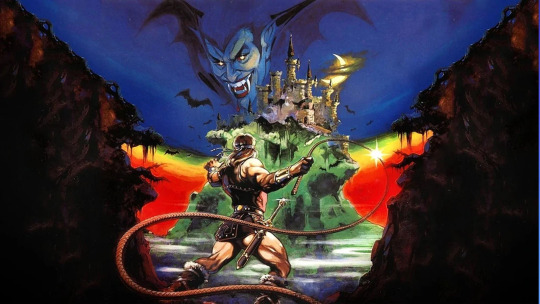
In ten days it will be World Dracula Day, and I’ve had the Count of Transylvania on the brain quite a lot lately. (A few of you can guess why.) Even though my Vincent Price countdown is still ongoing, I thus decided it was time to pay a bit of tribute to one of my favorite video game franchises, which happens to involve Dracula. I speak, of course, of Castlevania.
Originally designed to be simple platform action/adventure games with a spooky motif, the Castlevania series has evolved over the years. The core or “Classic” series has continued to have occasional spin-offs, and there’s also a reboot series called “Lords of Shadow,” and an animated series on Netflix, both of which make their own adjustments to the lore and characters while staying true to elements fans have come to love over the years. Over the course of the franchise’s history, many fabulous characters have come and gone - heroes and villains alike - and I decided, since Dracula is such a big part of Castlevania’s identity, it would be a fine idea to give a tribute on this day to my favorite figures from the series. Some of them may surprise you. With that said, let’s waste no more time! Grab your bullwhip or sword of choice, and prepare to enter battle! These are My Top 15 Castlevania Characters!
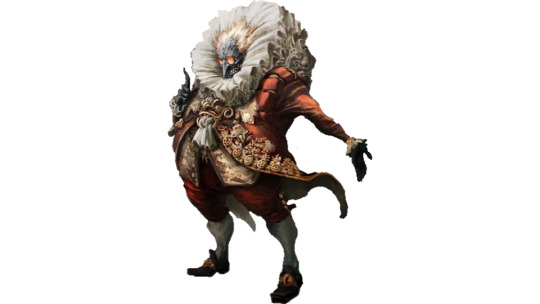
15. The Toy Maker.
The first two character entries on this countdown are exclusive to the aforementioned “Lords of Shadow” reboot trilogy. Originally intended as a re-VAMP-ing (I am so sorry) of the series for a new generation, this new line of interactive titles only lasted for three games. Fans were and still are mixed in their feelings about the Lords of Shadow reboot: some enjoyed it, while others felt it strayed too far, in terms of storytelling and style, from the original vision of the series. Personally, I like the Lords of Shadow trilogy; in fact, my favorite game of the franchise is from this trilogy…but that’s another story for another day. One of the more important antagonists of the reboot was this maniacal malefactor: a devilish scoundrel known simply as “The Toy Maker.” Loosely influenced by Jekyll & Hyde, the Toy Maker was once a kindly old soul, who used incredible science and alchemy to bring smiles to small children. However, a series of tragic events led to him being possessed by an evil force, under the influence of which he developed a sort of split-personality: flip-flopping between a sweet and gentle figure of fun, to an unhinged and sadistic hobgoblin who would make the Joker look as scary as a ball of cotton candy. The Toy Maker was an interesting and fun antagonist, and I really wish we could have seen more of him…however, the Lords of Shadow reboot trilogy remains the only place where he appears, so far.
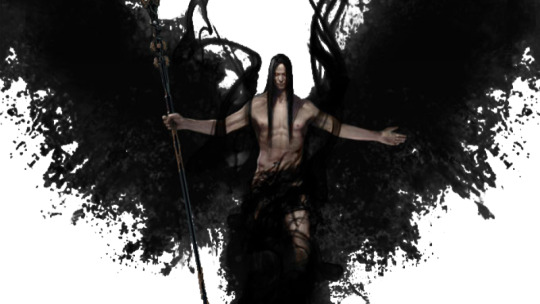
14. Satan.
This is the other LoS exclusive character on the countdown. As anyone who knows anythin about Castlevania knows, Count Dracula is the main antagonist of the Classic series of games, as well as the first two seasons of the animated series. However, in “Lords of Shadow,” the novel decision was made to make Dracula not the main villain, but instead the main protagonist (at least for two out of three games). So, with the Count now our hero rather than our villain, who was the antagonist to be? Who better than the Devil himself? Yep: in “Lords of Shadow,” Satan himself is the secret driving force behind much of the action of the story, and appears in the final act of the game as the true main villain pulling the strings behind the scenes. Although he was defeated, the Fallen Angel would return in “Lords of Shadow II” as the main antagonist, with Dracula facing his many minions and monsters before engaging in a rematch with Satan at the final bow. The character was masterfully played by the great Jason Isaacs, and I don’t think you could have picked a better main villain for this concept if you tried. However, once again, Satan only shows up in the LoS reboot, and despite his importance in the overarching story of the three games, his time onscreen is surprisingly small. Therefore, I don’t think it’s fair to rank him any higher.
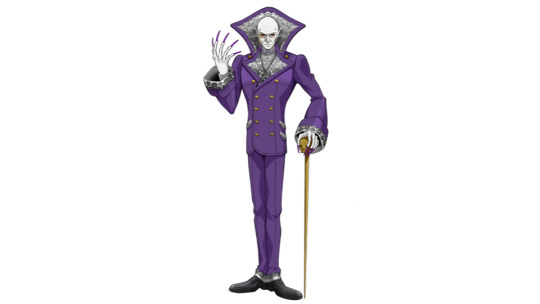
13. Brauner.
This is the first of many characters on this list to appear in more than one version of the Castlevania universe. Brauner first appeared as the main antagonist of one of my favorite games in the Classic series, “Portrait of Ruin.” He’s probably my favorite oneshot villain of the entire franchise. The character is a tragic antagonist: a former artist driven mad after the death of his daughters during World War I. Brauner studied black magic and became a vampire as a means of taking revenge against humanity, blaming the ills of the human race for the loss of his children. In his insanity, he came to believe two different young ladies were the reincarnations of his daughters, turning them into vampires and brainwashing them into believing the same. Brauner uses his powers to infuse his paintings with evil magic, turning them into weapons and then using special portraits to restore Castle Dracula. Unlike most bad guys in the series, Brauner has no connections to Dracula, nor any desires to resurrect him: he simply means to use the power of the Castle itself for his own diabolical and deranged purposes. Top it off with a character design inspired by Count Orlok from “Nosferatu,” and you have a memorable fiend indeed. The character returned in a reimagined form in the “Lords of Shadow” series, but in my opinion, this second incarnation was a major downgrade. This version of Brauner was a burly, monstrous vampire warrior, who acted as a lieutenant to the evil Carmilla. He was an intimidating presence, and a fun boss fight, but there really wasn’t much to say about him, and he was a far cry from the commanding and complex figure from the Classic series. I will say though: making him the brother, in that universe, of Olrox - another character from the Classic games inspired by Count Orlok - was a nice little in-joke.
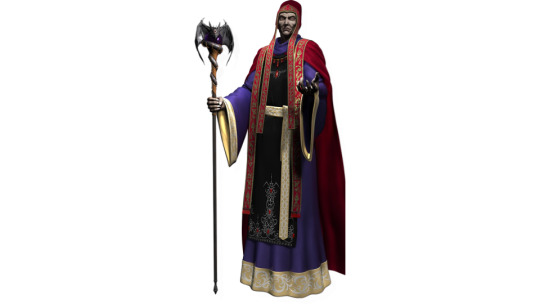
12. Shaft.
Shaft is a major antagonist in several of the Classic Castlevania games, most notably “Rondo of Blood,” its remake “Dracula X Chronicles,” and the ever-applauded “Symphony of the Night.” (And yes, you may snicker at his name and play a certain theme song whenever you read it, if you wish.) This fellow is a classic example of the “Dark Priest” or “Mad Priest” archetype. He’s dramatic, uses dark magic to face his foes, and zealously devoted to his Lord and Master: Dracula himself. In the aforementioned games, Shaft helps to resurrect Dracula, and aids him in his quest to destroy all of humanity. Admittedly, there’s not much else to this guy: he’s far from the most complex or sympathetic villain of the franchise, but he’s one that many people consider an iconic foe, and has even been the inspiration for other, rather similar villains in later games, such as Death’s alter-ego “Zead” in Curse of Darkness, and Guido Szandor from the Lords of Shadow games. Indeed, some have suggested that the Bishop played by Matt Frewer in the animated series may be inspired by Shaft. The two have a physical similarity, if nothing else, although Frewer’s Bishop is a zealous Christian rather than a vampire-worshiping occultist. Whatever the case, he’s an iconic scoundrel; when I think of the archetype, he’s one of the first characters I think of. For that reason above all, he earns his place in the ranks.
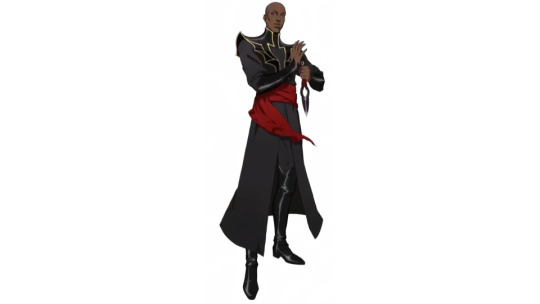
11. Isaac.
Isaac first showed up in one of the Classic games, “Curse of Darkness,” as a major antagonist. In the game, he was the friend-turned-nemesis of the main protagonist, Hector. Both of them once served as Dracula’s Devil Forgemasters, using arcane arts to help form armies of the undead for the Count. However, Hector eventually saw the light and left Dracula’s employ, while Isaac remained loyal to Dracula. Isaac orchestrates a series of cruel and sadistic trials to lure Hector back to Castle Dracula, intending to use Hector as a host body for Dracula’s evil spirit. This version of the character was already a fun one: an utterly deranged sadomasochist whose depravity served as a dark mirror to the hero, and whose connections to him made him a particularly personal threat. However, Isaac REALLY became fascinating in the Animated Series: this version kept the basics of the character, but changed his personality and story arc. Isaac lost his maniacal edge, and was made into a more tragic figure who, like Hector, learns to step out from Dracula’s shadow and find a new path in life. The pair were depicted more as rivals than nemeses, and many fans feel that Isaac’s journey through the show was one of the best parts of the overarching series. It was a great reimagining that actually improved on the established character from the games…but I personally just like other characters, across the whole franchise, a bit more, so I don’t think he deserves a spot in the Top 10. Sorry, Isaac; I still love ya.

10. Carmilla.
Carmilla – sometimes called “Camilla,” depending on the game you look at – can be seen as a study in the evolution of a character. She originally appeared as a recurring boss in the series, popping up in a few of the early games, such as “Simon’s Quest” and “Rondo of Blood” (and “Dracula X Chronicles” by extension). In these games, she wasn’t really a fully formed character in the truest sense; we didn’t know much about her. Her name was taken from the titular character of the most popular classical vampire story besides Dracula, “Carmilla,” and she was presumably inspired by the Hammer Horror films based on the story…but that was about it. There wasn’t really a lot of personality or major backstory to her. Things changed, however, with the game “Circle of the Moon.” While not set in the same continuity as the rest of the Classic series, the game was very notable in that it changed the character from a minor recurring boss figure to a major antagonist in her own right. In that game, much like Brauner in “Portrait of Ruin,” she was the true main antagonist, enacting an elaborate scheme to resurrect Count Dracula for her own evil ends. After this point, Carmilla started to get more and more attention: in the “Lords of Shadow” reboot, she was once again a fairly noteworthy antagonist, being one of the few characters to appear in both the first game and LoS2. Then, in the animated series (the version pictured here), she served as the secondary antagonist of the (appropriately) second season, and then became the main threat in the following season. She remained a major villain from that point on, basically up to the end of the show. With every installment that gives her more focus, Carmilla has become more fascinating and more twisted as a villainess. From humble beginnings to much greater prominence, it seems like anywhere Castlevania goes, Carmilla is destined to go with it.
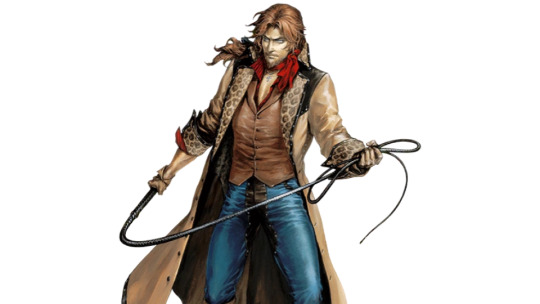
9. Julius Belmont.
When you really get down to it, Castlevania is the story of two opposing forces: Dracula, and the Belmont Clan. The Belmonts are a family of professional monster hunters; a noble race of warriors who have been fighting evil for generations. Each Belmont who takes up the weapons of their trade knows that they may be the one to face Dracula when the Count inevitably returns, and while all of them have similar goals, motivations, and abilities, they are generally unique from each other. Julius Belmont is a major character in the games “Dawn of Sorrow” and “Aria of Sorrow” (which are really the same story split in two). In these games, he is presented as the last of the Belmonts; the final member of his lineage. He is also one of the most powerful of his family, if not THE most powerful: experienced and gifted with knowledge passed down to him for centuries, and more than equipped to tackle Dracula. This becomes a problem, however, when he ends up befriending Soma Cruz – the main protagonist of the two games – and learns a dark secret about Soma’s being…but that’s another story. I really love Julius; a grizzled and INCREDIBLY powerful warrior, he has one of the most dynamic arcs of any character in the Castlevania series, starting off as a friend, briefly becoming an enemy, and then becoming something of a friendly rival and even a mentor. As the chronological last of the Classic Belmonts, he’s also quite important: with him, the clash between his family and Dracula effectively reaches its end. My only problem with Julius is not even really his fault: I really wish we could have gotten a game about the time Julius fought Dracula, with him as our main protagonist. It would have been nice to have him as our lead, rather than just a supporting role. It’s for this reason alone I don’t place him any higher. I guess one could argue we did get a chance to play with him in Dawn of Sorrow’s “Julius Mode,” but…that’s a bit of a different story.
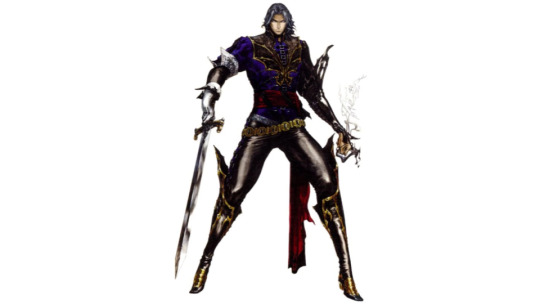
8. Hector.
Our first main protagonist character on the list…but interestingly, not a Belmont. Hector is the main character in “Curse of Darkness” (a personal favorite of mine from the Castlevania series), and is one of the most interesting main protagonists for a very specific reason: he’s a case of a villain turned hero. As I said before, Hector is a former servant of Dracula. He was once one of the Count’s most trusted soldiers – one of the few mortals Dracula cared about and considered a friend and worthy ally. However, after some time, Hector began to realize that Dracula’s crusade was not one he wanted to be a part of anymore, and he thus fled from his old master to find a new life. He fell in love, got married…and eventually saw his beloved wife killed as a result of the machinations of his former ally, Isaac. Wishing to avenge his wife, and stop both Dracula and Isaac once and for all, Hector thus gathers his weapons and goes back to the Castle to face his former comrades. Villains who are now heroes are always a great blend, and it makes the battle Hector goes through much more personal as a result. When he faces Isaac and the Count, it’s not just about his beloved’s death, but about facing his own inner darkness, and ensuring he can overcome it and see to it no one else gets hurt the same way. I also really loved the way the character was portrayed in the animated series, which stuck true to Hector’s origins while giving a new spin to his motivations and personality. (Much the same way the show did with Isaac.) He’s a character I don’t think gets enough credit from fans at times – I often hear other protagonists being spoken of more openly – but for me, he’s a shoe-in for the top ten.
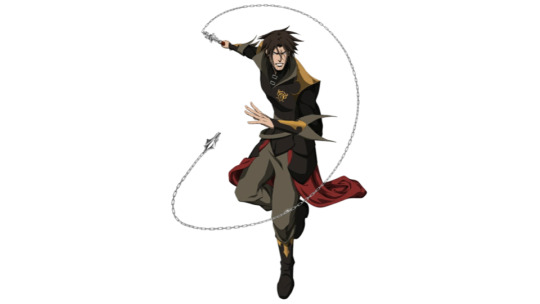
7. Trevor Belmont.
Of all the Belmont Clan, Trevor is one of the most recurring, and my personal favorite. Much like Carmilla, this is a character who has seen a lot of evolution. He first appeared in one of the games from the original trilogy, “Dracula’s Curse.” That game came out in 1989; back then, no one really cared THAT much about the story and characters: games were just games, so to speak. But as time went on, Trevor would appear in more titles, and his personality would evolve. He’d first appear as a major supporting player in “Curse of Darkness;” this version depicted Trevor as a noble but somewhat rash warrior, perhaps too overconfident in his own abilities. He starts off distrustful of Hector, but later becomes a valuable ally. This version would also appear as a supporting character in the fighting game “Castlevania: Judgment.” (Which could have been so much better, if people had been a little smarter when making it.) In the “Lords of Shadow” reboot, the character SORT OF reappeared: in that version, Trevor’s character was essentially combined with Alucard’s. (More on that matter later.) Finally, and most recently, Trevor appeared as the main character in the animated series. (That’s the version pictured.) In the show, Trevor is a disillusioned but ultimately good-hearted warrior, who has to learn to trust himself and others during his quest to slay Dracula and save the human race. After he and his allies do, indeed, defeat Dracula, Trevor’s adventures are not done, as other antagonists - such as Carmilla and Death - soon enact their own plans once the Count is out of the picture. All of these versions are interesting, and while many would probably name Simon or Richter as the most iconic Belmonts in the franchise, for me, Trevor will always be the best of the bunch.

6. St. Germain.
This cryptic character is yet another alumni from the game “Curse of Darkness.” (Don’t worry, I think he’s the last CoD-exclusive figure in the ranks.) He is the very definition of a scene-stealer: while his time in the game is actually relatively small, he makes a HUGE impact. This eccentric gentleman is a time traveler, and a perennial mystery. He frequently speaks in riddles, and while he seems to know a lot about Hector and the whole situation of the story, we actually don’t know very much about him at all. While it was later revealed in “Castlevania: Judgment” that St. Germain is a member of a secret organization of time travelers known as “The Time Watchers,” his exact motivations for his actions throughout Curse of Darkness are still unclear. In some ways he helps Hector along his journey, but he also serves as a dangerous boss battle, and tries to convince him to halt in his quest at one point. You’re never really sure what he’s going to do or say; an unpredictable trickster with powers we don’t fully understand. I always love these kinds of “Trickster God” or “Chaotic Entity” figures: characters like the Cheshire Cat, Puck, Mr. Mxyzptlk, and Q, for instance. Never truly evil nor truly good, and not fully understandable in their methods. St. Germain is a classic example of the same trope. The character was later adapted to the animated series: much like with the other Curse of Darkness characters, the series kept many of his original elements intact, but also added some new flourishes all its own. The show humanized St. Germain, giving him a more “grungy and gritty” reinterpretation of his classic design, and going into more detail about his origins and goals. Both takes on the character are magnificent, both for the same and for totally different reasons. Honestly, I’m sort of surprised he never made it into the Lords of Shadow reboot between these two incarnations…but que sera sera.
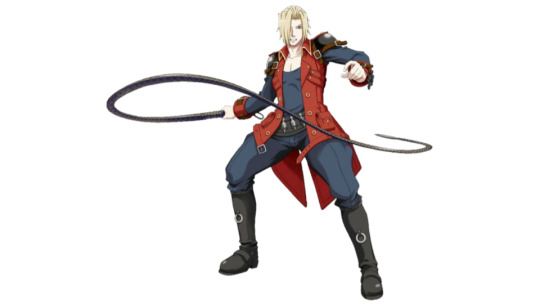
5. Jonathan Morris.
I’m not sure how renowned Jonathan Morris is among general fans of the Castlevania franchise, but for me, he is most assuredly one of my favorite protagonists in the series, and a big part of why “Portrait of Ruin” is among my favorite games in the franchise. First and foremost, there is his connection to the literature of Dracula: Jonathan is a descendant of Quincey Morris - a much-underrated character from the Bram Stoker novel. In the book, it is Quincey who is truly responsible for Dracula’s destruction. (His first name is also taken from a character in the book, Jonathan Harker.) I’ve always loved the fact that not only is the book canon with the rest of Castlevania (somehow), but that, of all characters, it’s Quincey Morris who gets attention. This also makes Jonathan one of the few American protagonists of the series. In fact, he comes from Texas; as a Texan myself, I find this incredibly appealing! But beyond the book and the geographical appeal, I love Jonathan for his personality: the game focuses a great deal on teamwork, both in gameplay and in storytelling. Jonathan does not travel alone: he is accompanied by his best friend, Charlotte Aulin. Charlotte is a wonderful character, too: the pair make a sort of “brains and brawn” duo: Charlotte is a good witch, who uses magical attacks and defenses, and is exceptionally smart. Not only is she skilled in sorcery, but she is also well-versed in science and other subjects, and always tries to use her head to confront a problem. Jonathan, in contrast, is all about muscles, using melee attacks with his sword (and, eventually, the legendary Vampire Killer whip), and is rather hotheaded and impetuous. He’s got a slight temper, and can be much too overconfident…but you know that his heart is in the right place, and he does listen to Charlotte when push comes to shove. Indeed, it’s Jonathan’s flaws that create much of the drama in the story, as he has to learn to rein in his impulses, among other things, in order to earn the power to use the magical Vampire Killer. Only with Charlotte’s help, and through learning to use his help, is Jonathan able to do what his grandfather, Quincey (and his father, John) were able to do, and defeat the Count of Transylvania.
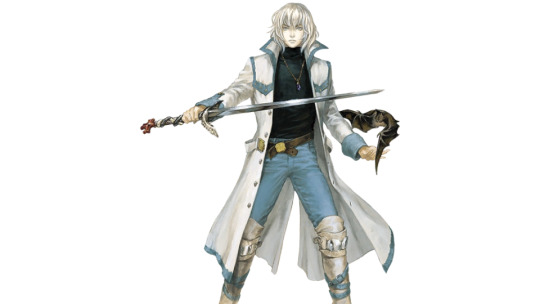
4. Soma Cruz.
Soma is the main character of “Aria of Sorrow” and its sequel/second half, “Dawn of Sorrow.” He’s also appeared in a few other games since. Many consider him to be possibly one of the greatest protagonists of any Castlevania game, and I am no exception. At the start of “Aria,” Soma is a seemingly more-or-less average High School student living in Japan. He has no family of his own, so he lives with a friend of his, Mina Hakuba. (Nice reference to Mina Harker there, games. A+.) One day – right the flip out of nowhere – Dracula’s Castle pops up in the middle of town, and Soma and Mina are trapped inside. At first, all Soma wants to do is leave the castle and save Mina, but as the story goes on, he starts to realize things about himself. He suddenly finds he has remarkable powers and surprising fighting skills he’d never been able to use before. He also discovers he has the power to consume the souls of anything (and anyone) he kills. At first, he naturally tries his best to be responsible and good with these powers…but things take a turn when it’s revealed why he has these abilities to begin with. Soma is actually a reincarnation of Dracula himself. The Count’s spirit dwells dormant inside of him, but it is foretold that someday he will manifest again. The remainder of “Aria” and the story of “Dawn” thus have Soma battling with his literal inner demon (or vampire, I suppose). The games play with the themes of destiny and fate, as the question constantly arises: is Soma doomed to BECOME Dracula, his life being erased? Or can he live his own life, the way he wants, without worrying about such a thing? Is there any compromise that can be reached between these two radical extremes? Is Soma Cruz a hero-in-the-making or a villain-to-be? It’s this constant struggle that makes Soma such an intriguing protagonist, as we, the player, pilot him on his journey towards whatever he must become. We care about him deeply, through all his trials and tribulations, and we don’t want to see him fall to darkness. The question is if he can truly avoid it. I won’t give away how things end, but suffice it to say, Soma’s adventures are some of the most poignant of any Castlevania character.

3. Death, a.k.a. The Grim Reaper.
Death is unavoidable, inevitable, and persistent. This is not only true of mortal life, but it is also true in the world of Castlevania. The Grim Reaper himself is the secondary antagonist of the entire franchise, and each separate version of the Castlevania universe reinterprets the character in a brand new way. In the Classic games, Death is Dracula’s second-in-command, and quite possibly his only true friend. The Reaper is the Count’s most loyal henchman; he is actually fought and faced in even more games than Dracula himself, usually as the penultimate boss (and, in at least one case, as the final boss). One of my favorite moments in the entire Castlevania series is the dual battle against both Dracula AND Death in “Portrait of Ruin”: by far my favorite boss fight of the entire franchise. In the “Lords of Shadow” Reboot, Death - also known as Zobek - is played by the redoubtable Patrick Stewart. (This is the version pictured here.) In this universe, things were turned on their head: Zobek starts off as an apparently friendly source of aid in the first game, but it’s ultimately revealed he’s just been using Gabriel (the future Count Dracula) as a means to his own evil ends. He returns in “Lords of Shadow II,” where he and Dracula forge an uneasy alliance…but by the end of the story, the pair once more find themselves at odds, leading to one of the best boss battles of the entire trilogy. While Satan is the main villain of the reboot, Zobek is Dracula’s TRUE nemesis. Finally, in the Animated Series, Death is reimagined once again, and combined with the penny dreadful figure Varney the Vampire. In the final season of the show, Varney is the main antagonist, and is ultimately revealed to be the Grim Reaper in disguise: he’s mighty peeved about Dracula’s destruction (albeit for completely different reasons than in the Classic games), and seeks revenge upon Trevor Belmont and his allies for the Count’s loss. This version was played with hilarious crudity by Malcolm McDowell. I love all three versions of the Reaper in the franchise. If there’s one thing these games prove without a shadow of a doubt, it’s that you cannot hide from Death.
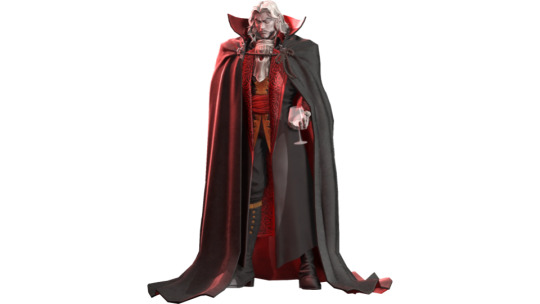
2. Count Dracula.
And here he is, at last! The King of the Vampires, the Prince of Darkness, the Count of Transylvania, He Who Sells Chocolate Cereal…Dracula! I bet you all thought he’d be number one, didn’t you? Well, surprisingly, no, but we’ll get to that issue in a minute. Let’s focus on good ol’ Drac himself for a second, shall we? Dracula is the main antagonist of the original Classic game series: he appears in nearly every title, usually acting as the final boss. Even in the stories where Dracula either does not appear or simply does not act as the last boss, however, his impact on the series’ storyline is profound. This version of the legendary villain is both sympathetic and sinister: his reasons for his evil deeds are complex and varied, but there can be no denying the cruelty of his wicked ways. He is insanely powerful, with many magical abilities and immunities; every time the heroes think he’s down for the count (no pun intended), Dracula always finds a new way to return and bedevil the world again. In the “Lords of Shadow” reboot, like I said earlier in the list, Dracula is actually reimagined greatly: in the first game, we meet him as a monster hunter called Gabriel Belmont. It isn’t until the second game, “Mirror of Fate,” when he becomes Count Dracula and assumes his usual role as the main antagonist. In “Lords of Shadow II,” the third game of the bunch, he acts once more as the main protagonist, this time as a sort of anti-hero, torn between both the heroism and the villainy of his past lives. Then, in the animated series, Dracula acts once again as the main antagonist of the first two seasons; although he is defeated by the end of Season 2, both his actions and those of the ones who beat him continue to plague everyone’s lives for the next couple seasons onward. Every single version of Dracula is absolutely glorious. Castlevania’s Count is easily one of my favorite versions of the character, and the Classic rendition is one of my favorite video game villains of all time. Yet he’s only second place on my list…what heresy have I cooked up, one wonders?
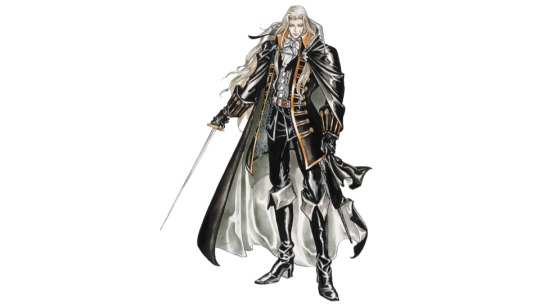
1. Alucard.
Who else could possibly top Dracula but his own son? While the Belmont clan may be the main collective protagonists of the series, Alucard, to me, is one of my favorite heroes in video game history, and a solid shoe-in for the number one spot here. Alucard is not technically a vampire, but a dhampir: half-human, half-vampire. He first appeared in the game “Dracula’s Curse.” However, Alucard really didn’t become popular or interesting until “Symphony of the Night.” In THAT game, we learned the full story of his origins, and the exact nature of his relationship with his bloodthirsty father. Alucard loves his father, and knows that, deep down, there is genuine good in him. But when Alucard’s mother, Lisa, is killed by witch hunters, the two forge different paths. Dracula’s instinct is vengeance, as he goes on a crusade to destroy all of mankind! Alucard, however, knows that isn’t what his mother would want, and chooses to defy his father as a result. After Symphony of the Night, Alucard continued to appear in numerous games, sometimes as a main protagonist, and sometimes as a featured supporting role. Like I said before, in the LoS reboot, his character was combined with Trevor Belmont. I’ve always had mixed feelings about this: on the one hand, it almost feels like a disservice to Trevor as a separate character. On the other hand, I actually didn’t mind the new take on Alucard, overall, as it kept many of the same ideas while twisting things slightly to fit the new universe and storyline. I still prefer the original more, however, and always will…which brings us to the animated series. This, I think, is probably the best Alucard we’ve ever gotten: sticking true to the original, but now giving him a sense of humor and playing with his own inner demons in some unique ways. Regardless of which universe you look at, however, I love the character’s swashbuckling and dramatic touches, while still being a legitimately compelling character. When I think of Castlevania, he is one of the first characters I think of. For all these reasons and more, I happily dub Alucard as My Favorite Castlevania Character.
HONORABLE MENTIONS INCLUDE…
Sypha Belnades.
Richter Belmont.
Charlotte Aulin.
Cornell.
#top 15#countdown#list#best#favorites#characters#castlevania#video games#tv#animation#lords of shadow#dracula#horror#netflix#alucard#grim reaper#soma cruz#jonathan morris#st. germain#trevor belmont#hector#julius belmont#carmilla#camilla#isaac#shaft#brauner#satan#toy maker#count dracula
10 notes
·
View notes
Text
King Willem-Alexander, Queen Máxima and Princess of Orange will visit to Caribbean part of the Kingdom – programme
His Majesty King Willem-Alexander, Her Majesty Queen Máxima and Her Royal Highness Catharina-Amalia, Princess of Orange, will pay a visit to the Caribbean part of the Kingdom of the Netherlands from Friday 27 January to Thursday 9 February 2023. They will visit Bonaire, Aruba and Curaçao before continuing to St Maarten, St Eustatius and Saba. The visit is intended to introduce the Princess of Orange to the Caribbean part of the Kingdom. The islands have put together a programme covering such topics as culture, nature, colonial history, sports and defence operations, and including meetings with island residents. The royal party will be accompanied by State Secretary for Kingdom Relations and Digitalisation Alexandra van Huffelen.
Bonaire, Friday 27 to Saturday 28 January
The royal party will arrive in Bonaire on Friday afternoon, where they will be welcomed by Governor Edison Rijna. On Saturday morning the governor will receive the party at his official residence, together with members of the island council and island executive.
The King and Queen and the Princess of Orange will then visit the slave huts at Witte Pan, which are reminders of the history of slavery in Bonaire. Following this they will travel along the west coast and attend Nos Zjilea at Cultural Park Mangazina di Rei, an event which highlights Bonaire’s cultural and historical heritage. The party will view an exhibition on the island’s history. Young people will tell them about their local area, a family of four generations will bake bread in a stone oven and primary school children will perform with their learning orchestra. This will be followed by a lunch with Bonaire residents at Arawak.
In the afternoon the party will watch a windsurfing demonstration in Sorobon Bay. Bonaire is reputed for its good windsurfing and the talented windsurfers it produces. The King and Queen and the Princess of Orange will then talk to junior rangers from the STINAPA national park foundation about coastal nature conservation, especially of the mangroves which protect the coast. The party will tour the bay and mangroves by boat.
The visit to Bonaire will draw to a close in Kralendijk with a trip to Taste of Bonaire, a cultural market with local products, culinary offerings and musical performances.
Aruba, Monday 30 January
On Monday morning the King and Queen and the Princess of Orange will arrive in Oranjestad, where a welcome ceremony will take place on Wilhelmina Square. Following a meeting with Governor Alfsonso Boekhoudt, the party will walk to the parliament to speak with party leaders. They will then walk to the Cocolishi building, which houses Aruba’s cabinet. There they will have lunch with the prime minister and ministers. On the way they will interact with members of the public and see performances by a local learning orchestra and youth choir.
In the afternoon the party will continue to San Nicolas, a town with an artistic vibe. At Filomena College secondary school they will attend a performance about Boy Ecury, an Aruban-Dutch resistance hero. This will take place next to a mural dedicated to him. Other colourful murals, created by local and international artists during Aruba Art Fair, will be highlighted during a walk through the town. The party will also pay a brief visit to the Museum of Industry and will watch street performances by young people, featuring breakdance, spoken word and a carnival show.
Aruba, Tuesday 31 January
In the morning the King and Queen and the Princess of Orange will visit Arikok National Park. This protected area covers 20% of Aruba. The party will go on a hike in the park, meet the makers of a nature documentary about the six islands and discuss nature conservation and management with junior rangers at the Center of Cultivation. The royal party will then continue on to Royal Aruba Aloe, a company founded in 1890, where they will speak with staff and see how the company cultivates aloe vera and uses it in making skincare products.
In the afternoon the party will visit the University of Aruba. They will attend part of a lecture on Caribbean law and talk with students. The King and Princess of Orange will then visit the Soccer Academy at Compleho Deportivo Frans Figaroa, which provides training for talented young people in collaboration with the Royal Netherlands Football Association (KNVB). Queen Máxima will pay a field visit to a vegetable farmer who attends a business academy run by credit provider Qredits.
In the evening the Bon Bini Festival will take place at Fort Zoutman. Following a walk around Plaza Padú, where there will be music and a presentation of local products, the royal party will watch an exploratory show on Aruban culture and history, with Caribbean music and dance.
Aruba/Curaçao, Wednesday 1 February
The King and Queen and the Princess of Orange will sail from Aruba to Curaçao on patrol ship HNLMS Holland, which is stationed in the Caribbean part of the Kingdom. On board they will discuss the Ministry of Defence’s operations in the Caribbean region, followed by a tour of the vessel and demonstrations. The Defence organisation works to keep all parts of the Kingdom safe. Military units stationed in the region fulfil three key tasks: to protect the Kingdom’s territorial integrity, to promote and maintain the international legal order, and to support the local authorities. For example, they carry out operations to counter drug smuggling, provide assistance in sea rescues and provide emergency relief after hurricanes.
Upon arrival in Willemstad’s St Anna Bay the royal party will be greeted by Governor Lucille George-Wout. This will be followed by a welcome ceremony marking the start of their visit to Curaçao.
Curaçao, Thursday 2 February
The visit to Curaçao will commence in Willemstad with a walk over the Queen Emma Bridge to Brión Square, where the King will give the starting signal for registration for the King’s Games. Primary school children will take part in sports contests on the square. Afterwards the party will tour the Otrobanda district, talking to residents and artists and watching musical performances. This will be followed by a lunch with representatives of the Curaçaoan authorities in the Governor’s Palace.
In the afternoon the royal party will visit the Punda and Scharloo districts. In Punda the King will strike a coin to mark the 25th anniversary of Willemstad becoming a UNESCO World Heritage site. The party will also paint a chichi, a traditional Curaçaoan sculpture symbolising the responsible eldest sister in a family. They will then go on a walk through the Scharloo district, with street art, music and youth sports projects. The walking tour will end at Princess Amalia Bridge, where the party will listen to Amalia Waltz, a piece composed for the Princess.
In the evening a dinner will be held at the Cathedral of Thorns, attended by 21 residents who make a valuable contribution to their community. The number of guests reflects the fact that it is the royal couple’s 21st wedding anniversary on that day.
Curaçao, Friday 3 February
In the morning the royal party will visit the Tula Museum at Landhuis Knip on the former plantation where Tula started a slave revolt in 1795. They will watch a performance about the revolt and speak with descendants of enslaved people. They will then visit Hofi Mango, a former sugar plantation that is now a nature park where, among other things, horticultural education is provided.
In the afternoon the King and Queen and the Princess of Orange will attend a presentation on Cas Abao beach by Sea Turtle Conservation Curaçao and the Dutch Caribbean Nature Alliance (DCNA) about protected marine areas and preserving the sea turtle population.
The trip to Curaçao will conclude with a visit to a Tumba Music Concert with carnival acts at Brión Square. The concert is being held in honour of the late Boy Dap, who is regarded as the king of Tumba, a genre of music and dance originating in Africa.
St Maarten, Monday 6 February
The King and Queen and the Princess of Orange will be welcomed at Princess Juliana International Airport by the Governor of St Maarten Ajamu Baly and Prime Minister Silveria Jacobs. The first day of the visit will focus on the country’s reconstruction following the devastation caused by hurricane Irma in September 2017. The royal party will view the airport which is currently still being rebuilt. During a visit to the emergency and disaster response services, the King and Queen and the Princess of Orange will assist in a disaster exercise. They will then visit the St Maarten Medical Center. This hospital plays a key role in the region and also treats many patients from St Eustatius and Saba. The King, Queen and Princess will speak to patients and will be updated on the expansion of the hospital. They will then have lunch with the cabinet.
In the afternoon the royal party will be taken on the Color Me SXM mural walk in Philipsburg. These murals are designed to brighten up Philipsburg, as many of the town’s buildings are still vacant or damaged following the hurricane. The day will conclude with lively displays of St Maarten’s culture along a walking route and a concert on the Boardwalk in Philipsburg.
St Maarten, Tuesday 7 February
In the morning the King and Queen and the Princess of Orange will visit Fort Amsterdam. Here they will go on a birding excursion in search of the brown pelican, the island’s national bird. They will also learn about the fort’s history. They will then meet members of St Maarten’s parliament and youth parliament. At the White and Yellow Cross residential home for older people and people with a disability, the royal party will learn more about the daytime activities organised for residents. Next, they will visit a science fair, where primary and secondary school pupils will present their solutions for reducing plastic waste on the island.
In the afternoon the King and Queen and the Princess of Orange will visit Resources for Community Resilience (R4CR). R4CR disburses World Bank funds to projects aimed at rebuilding St Maarten after hurricane Irma via a Trust Fund. The party will speak with representatives of civil society organisations about their projects and with young people about their work at various organisations. They will then visit a school garden project where they will talk to pupils about their work in the garden and the importance of gardening for their mental health. In Emilio Wilson Park schoolchildren will talk about their dreams for the future of St Maarten and plant yellow sage, the island’s national flower. Following this the King and Queen and the Princess of Orange will visit St Peters Hill, where they will learn about nature conservation in St Maarten. This hill borders on the French part of the island. The afternoon will conclude with a youth baseball tournament.
In the evening the party will attend a reception hosted by the governor.
St Eustatius, Wednesday 8 February
The royal party will be welcomed to St Eustatius by Government Commissioner Alida Francis and will meet representatives of the island’s authorities. During a walk through Oranjestad’s historical centre they will meet a number of Statia residents who will speak about their life on the island. The history of slavery on the island will also be discussed. After the walk, the King and Queen and the Princess of Orange will attend a debate with young people about their future on the island.
After a lunch with island residents, the royal party will go to Zeelandia Beach where they will hear about local nature management and the annual STATIA DOET Beach Clean Up. After this they will visit a community garden, where they will speak with farmers about the food system on the island. Because a lot of food is imported, prices are high and there is a shortage of fresh produce. The party will then join schoolchildren in a basketball practice session. The visit to St Eustatius will conclude with an event at Fort Oranje, focusing on the island’s cultural heritage.
Saba, Thursday 9 February
The royal visit will conclude on Saba. After being received by Island Governor Jonathan Johnson, the King and Queen and the Princess of Orange will hear about Saba’s energy supply. Saba aspires to become energy neutral within the next few years. The royal party will then proceed to the village of Zion’s Hill for a presentation on lacemaking, a Saban tradition. On a walk through the village of Windwardside the King and Queen and the Princess with meet local residents. At the Eugenius Center they will meet older residents who will also give a theatre performance. The party also speak with artists and business owners about their work. The party will also step into the Harry L. Johnson Museum where they will learn about life on Saba through the years.
After a lunch with representatives of the Saban authorities, the royal party will visit the Expertise Center Education Care (EC2) in St Johns, that supports vulnerable schoolchildren. The organisation won an Orange Fund ‘Appeltje van Oranje’ award in 2021. The party will then depart for the harbour, where they will find out more about Saba’s new harbour project. Scientists will tell them about a project on Diadema sea urchins, which help protect coral reefs by eating the algae that would otherwise overrun the coral. The final component of the programme will see the King and Queen and the Princess of Orange visit The Bottom where they will play sports with children on the world’s largest Cruyff Court.
14 notes
·
View notes
Text
Pending the release of DA:D, i can just make up whatever will happen, so here's a series of events i want to think about
So the First Warden has eyes on the throne of the Anderfels and deeply desires to increase his (and by association the Wardens') political power. For this little exercise, he succeeds
The Thedosian reaction is mixed. Many may think of this as a grievous overstep of Warden authority, some as an inevitability, and a few might even approve. Ferelden by and large greatly disapproves. The memory of the Dryden Rebellion is not easily forgotten
My Hero of Ferelden, Novhen Tabris, is no exception (albeit not because of Dryden specifically). He's been opposed the Wardens being in charge of Amaranthine since Day 1. A Warden-King is so so much worse. Wardens and politics should not mix
As a show of good faith to the Fereldan public, Novhen arranges with the crown for control of Amaranthine to be transferred to Nathaniel's nephew. Wardens keep the keep in the divorce though, sorry
This endears him further to the general Fereldan populace, and more relevantly, is a huge middle finger to the First Warden's machinations. Tensions have been brewing among the Order for a while, but this is what the history books will record as the final straw before it snaps it into a full rebellion. Novhen reaches out to the Orlesian (and Marcher) commander(s), and the two (three?) enter a formal alliance. While technically they are of the same rank, the Hero of Ferelden is considered the de facto leader among them
If Zevran has completed his takeover of the Antivan Crows by this point, that offers the southern Wardens a powerful ally. While Crows are already disinclined to take contracts on Grey Wardens, this can securely prevent them from being contracted against the HoF or his allies. Zevran would likely even volunteer some to serve as extra security with his special friends and family discount of free
With Leliana as Divine, Novhen is able to petition for the Chantry's support for his side of the conflict with relative ease. While this officially amounts to little, it does great work to erode the First Warden's support even among the Ander Wardens
It will be during this period that the DA:D protag uses Novhen's research to complete a cure to the Taint and the Blight. Who they share this information with will be a major factor in determining who succeeds in the Warden conflict, and if they know what's good for them, they're going to share it with Novhen. Maker knows he'll need it if the First Warden uses this as his chance to announce the return of griffons from extinction
10 notes
·
View notes
Note
OC question (not really a question but whatever): pick a work written in classical Greek or Latin to recommend to each of your OCs! What would they enjoy reading or which works would include valuable information for them?
Ohhh this is a good one!! Thanks Vanamo!! You know me well so you’re not gonna be surprised when this is a long answer 😅
I think Herah would really love the poetry of Sappho. I know this is kind of an obvious choice but I think the personal nature of lyric poetry would suit her well. The sense of community and the performance context are things I think would remind her of her Tal Vashoth community. I’ll probably do a post on this at some point but, since it’s relevant here, I think that the Vashoth probably have an oral tradition given that that’s an important part of almost all communities ever. It’s a way for members of a community to connect to one another over common stories/experiences, a way to impose a moral code, and to define how we ought to treat each other and what happens when that goes wrong. Connecting with those ideas and exploring how another culture is similar/different to her own would be really rewarding for Herah.
Also hearing Sappho communicate directly with Aphrodite, reading her symptoms of love, listening her play into existing myth and look at it in new ways would be really appealing to Herah. The differences in language and metre would also give her the opportunity to get stuck in and do the kind of close analysis that she loves so much. She’d really be able to dig her teeth into it and see all the nuances of word order and emphasis, and admire how compact and economical these poems are.
I know this is cheating but I just wanna add that I think Herah would really love to read some Athenian comedy with Sera. They’d have so much fun with the Cyclops with all its sex jokes and taking the absolute piss out of Odysseus as this self-important war hero whose fame means nothing without a social framework in which to operate.
After much debate, I think I’d recommend to Naerselle the Iliad. She’d really like the close descriptions of battle (I almost said Julius Caesar’s Gallic Wars for that reason) but I think she’d really understand the sorrow of Achilles, his attempt to defy destiny, how his action (or inaction) hurt a lot of people, but in time he realises just how much that cost him on a personal level. Not only that though, I think she’d also relate to Hector at times, not because of his nobility (in the moral sense) but because of how alone he is at times even when he has such an extensive family. She and her own family are mostly at odds and I think she sees something of them in Paris making her by extension a Hector-like figure.
Given that she’s Andrastian (probably my OC with the strongest sense of faith), I think she’d enjoy how present the gods are in this text, even if they are perhaps portrayed as ambiguous at times. Her faith doesn’t necessarily mean that she thinks that the Maker has a strong sense of right and wrong which he imposes upon the world. She sees it more as he has an overarching plan (like Zeus’ Βουλή in the proem) which may indeed require suffering along the way.
I know Senna would love historiography so I think I’d recommend Sallust’s War on Catiline or Jugurthine War. Sallust’s style is moralising and very self-conscious as his discussion of events often reveals either explicitly or implicitly where he himself lies politically. It’s also pretty important to him to justify why he’s taking the time to write history when he maybe should be dedicating time to politics. The position of being stuck between personal pursuit and political duty is something Senna could relate to, being at the centre of politics for as long as she can remember. Sallust, in my opinion, has this surface view of binary morality, but also his deeper ambiguity on whether we are right to accept the official narrative (particularly in the Catiline). I think that’d feel familiar to Senna, especially after her exile from Orzammar.
I also think it’d be helpful for her from a rhetorical and political point of view as seeing the shades of grey and how people might do bad things for good reasons or vice versa would give her perspective on how she herself should or could view the world around her. The end of the Catiline is particularly striking because all of the remaining supporters of the Catilinarian conspiracy fight valiantly and to the death — notably within no wounds to the back (ie they didn’t flee from battle). Seeing a political opposition be so sure that what they’re doing is right might make her question her own actions and think about how she’ll be remembered in history.
For Nesiril, I’m stuck between either Euripides’ Medea or Aeschylus’ Agamemnon. I think they’d like to see how gender roles can be pushed and even totally disregarded at times and she’d definitely take the reading of extreme support of the women in these plays in the face of the abominable actions of the men around them. Moreover, I think they’d see Jason and Agamemnon as parallels for the Templars in the Circle — controlling, power-hungry, and neglecting their duties or outright contradicting them.
I think she’d also see herself in Medea in particular from a gender point of view because there’s this scene in which Medea renounces her femininity and basically steps outside of the gender binary. Given that Nesiril is non-binary, I think she’d find this a really powerful moment and really gender affirming.
#answered asks#thanks for the ask!#dragon age#oc: herah adaar#oc: naerselle cadash#oc: senna aeducan#oc: nesiril surana#hannah talks classics
2 notes
·
View notes
Note
i'm pretty bad at watching things as episodes come out. i'll be the first to admit that i'm not the patient type and waiting a week after cliffhangers just drives me crazy. i usually wait until things are finished airing so i can watch it all at once!
what are some of your favorite anime ops/eds? idk if it's just me, but i feel like i learn a lot about a person from knowing their taste in ops/eds haha.
- your animanga secret santa
@mx-sinisters this is a REALLY late reply but I still wanted to answer and since I now know this message was from you, I figured I'd mention you in case you still care. xD
oh boy my favorite ops/eds... I'll start with ops:
Attack on Titan S3 OP1, "Red Swan" by Yoshiki ft. Hyde
Durarara!! OP1, "Uragiri no Yuuyake" by THEATRE BROOK
Jujutsu Kaisen OP2, "Vivid Vice" by Who-ya Extended
Kekkai Sensen OP1, "Hello,world!" by BUMP OF CHICKEN
Promised Neverland OP1, "Touch off" by UVERworld
Railgun OP1, "Only My Railgun" by fripside
Railgun S OP1, "Sister's Noise" by fripside
SK8 the Infinity OP1, "Paradise" by Rude-α
Tower of God OP1, "TOP" by Stray Kids
World Trigger OP1, "GIRIGIRI" by Sonar Pocket
World Trigger S2 OP1, "Force" by TOMORROW X TOGETHER
Yuri!!! on Ice OP1, "History Maker" by Dean Fujioka
there are others that I like, but those are probably my top faves! now for eds (ngl, I don't pay nearly as much attention to eds as ops, but there are still some that stand out to me)...
Boku no Hero Academia ED3, "Datte Atashi no Hero." by LiSA
Fate/Unlimited Blade Works ED2, "ring your bell" by Kalafina
Jujutsu Kaisen ED1, "Lost in Paradise" by ALI
Kekkai Sensen ED1, "Sugar Song to Bitter Step" by UNISON SQUARE GARDEN
Kyoukai no Kanata ED1, "Daisy" by STEREO DIVE FOUNDATION
Madoka Magica ED, "Magia" by Kalafina
World Trigger S3 ED1, "Ungai Shoukei" by FantasticYouth
and there ya have it! thanks for asking so I could share my love for all of these lmao. sorry again that this is late and technically the secret santa event is over, but I still wanted to mention these faves! I hope you're doing well, sin~ what are some of your faves, if I may ask??
2 notes
·
View notes
Text
Sorry, I may be a Canadian aromantic that usually avoids posting about current events, but today I'm annoyed.
Let me tell you about how my nephew exists because of an abortion. No, not in the "getting an abortion in high school in order to lead a fulfilling life" narrative. He was conceived only a month or so after an abortion.
My sister was pregnant twice in 2018. The first conception was in December 2017, approximately. She is married, already has a daughter, and she and her husband were ready to have another kid. About two months or so in, she goes in for a checkup, and they make a sad discovery.
The fetus in her womb was dead.
Since we're in Canada and have better healthcare up here, she and the doctors immediately booked the appointment for a type of inducement to remove the dead fetus from her womb. Yes, also known as a type of abortion.
The operation happened sometime around March 2018. My sister recovered just fine, got back to sexual activities, and got pregnant again around April 2018. This fetus was healthy, and so was born at the end of December. The baby boy is now 3.5 years old, and has endless energy and the world's potential at his fingertips.
I've seen the stories that circulate around here about abortions being needed for medical purposes when a fetus dies in the womb. I've seen the stories about how women are pressured by their church communities to refuse abortions, and who end up dying because a dead fetus was rotting in their womb, only for those same church people to say "God works in mysterious ways".
Really? Would you folks say my sister should've let that dead fetus rot in her womb? Would you deliberately ignore that, by having the abortion, she was able to carry on living and produce a healthy child? Would you have wanted me to lose my sister? My niece to lose her mother? My parents to lose their daughter?
And what if it was God's will for my sister to miscarry this first fetus, so that the next one could thrive? For saying "God works in mysterious ways" a lot, you're forgetting the parable of the Good Samaritan. While the first two people ignore the poor man on the road and let the man suffer, it's the person who helps the poor person who Jesus praised. Have you not considered that human science and medicine is what God wants? Have you not considered that God's way is for us to help each other in kindness and compassion, rather than condemn whose who don't follow your ways? Why is the "Pray for God to do this for someone" the default answer to bad news, when a human can just do something to solve the problem?
So, once again, why are you preventing women from having abortions to remove dead fetuses from their wombs, then saying "God works in mysterious ways" when those women die preventable deaths? Wouldn't it be God's way to save their lives, so that they can go on to make them as religiously fulfilling as possible? What if their next child was meant to be the next Einstein? What if their next multiple children solved all the world's problems?
Oh yes, I'm spinning that old-fashioned narrative on you. Because of an abortion, my nephew exists, and therefore has the world's potential in front of him. He could prove to solve the world's problems, and make it into the history books.
But no, you wouldn't have let him exist, would you? Because my sister had to have an abortion on a previous fetus before she could conceive him? You would deny the world the next Einsteins, the next heroes, the next history-makers, simply because their mothers had another fetus die in their wombs before they could be conceived?
So I ask you one final time, are you saying that, if choosing between a dead fetus and an energetic 3-year-old boy with the world's potential at his fingertips, you'd choose to protect a dead fetus?
1 note
·
View note
Video
youtube
Cleopatra: The Multilingual Queen of Diplomacy and Love. Rosa Parks is widely recognized not just for her refusal to surrender her bus seat to a white passenger, but as a crucial figure in sparking the American Civil Rights Movement. Her defiance on December 1, 1955, in Montgomery, Alabama, initiated the Montgomery Bus Boycott, a significant protest leading to bus desegregation in the city. A committed civil rights activist, Parks' involvement extended well beyond this event, as she actively participated in the NAACP and dedicated her life to racial equality. Often celebrated as the "Mother of the Civil Rights Movement," Parks' actions symbolize the fight for racial justice, inspiring countless individuals to contribute to the cause. Her legacy endures as a testament to the power of quiet courage and the profound effects of standing firm in one's convictions. Rosa Parks was more than the sum of her actions on a single day; she was a seamstress, a partner, a believer, and an individual shaped by a lifetime of experiences with racism. Understanding Rosa Parks involves recognizing the depth of her character, the significance of her actions, and the lasting relevance of her fight for justice and equality. #RosaParks, #CivilRightsMovement, #MontgomeryBusBoycott, #MotherOfTheCivilRights, #StandUpForWhatYouBelieve, #LegacyOfCourage, #QuietCourage, #RacialEquality, #NAACP, #JusticeForAll, #Activism, #Inspiration, #AmericanHero, #FightAgainstRacism, #EqualityForAll, #CourageousActs, #HistoryMakers, #SocialJustice Warrior, #ChangeMaker, #HeroesOfHistory ,#englishhistory ,#blackhistorymonth , #history Rosa Parks, Civil Rights Movement, Montgomery Bus Boycott, Mother Of The Civil Rights, Stand Up For What You Believe, Legacy Of Courage, Quiet Courage, Racial Equality, NAACP, Justice For All, Activism, Inspiration, American Hero, Fight Against Racism, Equality For All, Courageous Acts, History Makers, Social Justice Warrior, Change Maker, Heroes Of History, english history ,history,blackhistorymonth
0 notes
Text
“Huzza!” Toasting a New Nation, 1760-1815 by Timothy Symington #History #RevolutionaryWar #AmericanRevolution

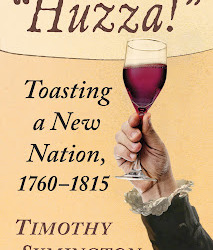
“Huzza!” Toasting a New Nation, 1760-1815
Timothy Symington
Genre: Nonfiction/History
Publisher: McFarland Books
Date of Publication: September 29, 2023
ISBN: 978-1-4766-9315-6 Print
ISBN: 978-1-4766-5056-2 ebook
ASIN: BOCK62JP5L
Number of pages: 273
Word Count: 125,000.
Tagline: Drinking toasts to the American Revolution and beyond!
Book Description:
During the early years of the United States, toasts captured popular sentiments regarding people and events. Sometimes they were used to spread national ideology and partisan political views. They could even be “weaponized” against political opponents, such as during the bitter election between John Adams and Thomas Jefferson in 1800. “Huzza!” Toasting a New Nation, 1760-1815 is a retelling of the familiar historical narrative, but toasts are used to tell the story of the events and people between the American Revolution and the War of 1812.
Amazon Mcfarland Books
Excerpt:
Israel Putnam of Connecticut, who led the rebels at Bunker Hill in June, was one of the first to be singled out for honors when the war began. The Connecticut Gazette printed toasts from a July 25 dinner in London attended by the Freeholders of Middlesex. General Putnam was toasted “and all those American Heroes, who, like men, nobly prefer death to slavery and chains.” Sons of Liberty leader Dr. Joseph Warren, who was killed on the battlefield, received the following toast from the Field Officers of the Sixth Brigade in Cambridge: “Immortal Honor to that Patriot and Hero Doctor Joseph Warren, and the Brave American troops, who fought the Battle of Charlestown on the 17th of June 1775.” This list of toasts, appearing in the August 21, 1775, issue of the Boston Gazette, or Country Journal started with a toast to the Continental Congress instead of to the British monarch. The officers raised their glasses instead to all the colonies, the Stamp Act riots, Lexington and Concord, and an end to the “present unhappy Disputes.” Dr. Warren would be a consistently toasted figure into the early 1800s.
George Washington replaced George III as the main recipient of toasts, becoming the most toasted individual in the new nation. The King was now the enemy. Even English supporters of colonial rights, such as John Wilkes and Edmund Burke, were replaced by American military heroes. English support for the rights of the colonists, however, had not disappeared. The Virginia Gazette printed toasts the London Association made in October 1775. Association members wished for “axes and halters, at public expence, to all those who attempt to trample on the liberties of their fellow subjects, either in Great Britain or America,” and that “kings remember that they were made for their subjects, and not their subjects for them.”
The former British corset-maker Thomas Paine brilliantly explained why the colonists should no longer rely on the King to protect their liberties. His pamphlet, Common Sense, demanded that Americans free themselves of Britain’s control. Paine wrote that “One of the strongest natural proofs of the folly of hereditary right in Kings, is that nature disapproves it, otherwise she would not so frequently turn it into ridicule, by giving mankind an Ass for a Lion.” His words reached everyone in the colonies, and so he and his work were toasted: “May the INDEPENDENT principles of COMMON SENSE be confirmed throughout the United Colonies.”
Most colonies had already taken Paine’s advice to heart and declared themselves to be independent states. Members of the Virginia convention calling for a resolution for national independence gave toasts in May: “The American independent states” and “The Grand Congress of the United States, and their respected legislatures.” Washington attended a feast at the Queen’s Head Tavern in New York City, where toasts were given to the Continental Congress and the American army, and to the memory of General Richard Montgomery, killed in the disastrous invasion of Quebec in December 1775. The final toast was “to ‘Civil and religious liberty to all mankind’—mankind, that is, except Tories.” Tories, the conservative supporters of the Crown, received extra abuse in the Patriots’ toasts: “Sore Eyes to all Tories, and a Chestnut Burr for an Eye Stone.”

About the Author:
Timothy Symington received his Bachelor of Arts degree in History from Saint Anselm College and his Master of Arts degree in American History from Adams State University. A former educator, he now contributes to the Journal of the American Revolution. “Huzza!” Toasting a New Nation, 1760-1815 is his first book.
Twitter: https://twitter.com/ToastFab4
Instagram: https://www.instagram.com/tim.symington/
YouTube: https://www.youtube.com/@Toastmaster-yu9eq
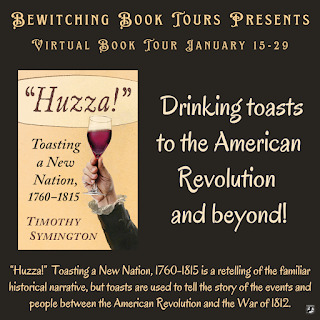
0 notes
Text
Republic Day 26 January Poster Maker App - Find Best Republic Day Poster Maker Online
Wishing Happy Republic Day to ALL!!
Design free brochures, posters, banners, social media graphics, and videos for the 26th of January in only a few minutes. Select from a variety of attractive templates to impress your viewers.
We update our app every day with Festivals, Trending, new templates, Business Posts, Promotional Templates, Daily Posts (Like, Motivational, Leader Quotes, Business Ethics, Good Morning, Good evening, Good Night, Suvichar, Sports Devotional, Rest in Peace, and Wishes Posts, among others).
How to use Republic Day Poster Maker App:
1. Signup with your Mobile Number
2. Add details like Company Logo, Name, Mobile Number, and Website & Address
3. Select Category to make Poster
4. Choose Festival Frame or Video
5. Layout includes features like Add/Alter Text Color & Stylish Font
6. Save or Download Final Post in Gallery or at your file
7. Share your Happy Republic Day Poster & Video with Music.
We include all Indian celebrations, national and international days, Jayanti, Anniversary, Punyatithi, celebrity birthdays, and all religious holiday celebrations, special people and important days, political leaders' post-incident posts, popular posts, famous personality birthday posts, and more.
Republic Day Poster festival post is one of the most effective brand advancement apps, so only apps are going to be here to create your corporate identity all over the globe with just a click. You just need to register your number,Company Logo, Name, Mobile Number, and Website & Address, Select Category to make Poster, Choose Festival Frame or Video, Share your Happy Republic Day Poster & Video with Music Excellent!! And you are at the correct location.
26 January Photo Editor is a helpful app that allows you to personalise the images you upload. Save those memorable memories on January 26th with the Republic Day Photo Frames. In this application, we have included Republic Day frames for your creativity.
Try our greatest Republic Day Photo Frame 2024, also known as the 26 January Republic Day Poster Maker, for completely free, and make beautiful your photographs with the most stunning 26 January photo theme. You can now share your emotions for the country India.
By Making26 January Poster Maker Let us cheer as we embrace the freedom of living independently in our nation in a pleasant, valuable, and respectful way by honouring our National Heroes, Mahatma Gandhi, Jawaharlal Nehru, Rani Lakshmi Bai, Bhagat Singh, Sardar Vallabhbhai Patel, Bal Gangadhar Tilak, Subhas Chandra Bose, Mangal Pandey, Chandra Shekhar Azad and who granted us freedom after enduring pain and losing their own lives for us.
India celebrates Republic Day on January 26th every year to remember the day the Indian Constitution became effect in 1950. Flag-raising events and parade by militarised soldiers and students are staged throughout the country in celebration of this major milestone. The biggest and best of these parades is conducted on Kartavya Path in New Delhi. On this day in history, Indians get together will be held to remember the sacrifices that were made by those who fought for freedom and renew their commitment to a unified growing, multicultural India.
Our Krantikari constitutes a reminder of the efforts made by our freedom warriors, as well as the duty we have to defend the values of democracy for which they struggled. As we celebrate this day, we focus on our country's achievement and the difficulties that exist beyond.
Republic Day Festival Post Maker is a very easy and simple poster maker app that help individuals, entrepreneurs, and business in conniving Festival Poster, Ads Banners, Digital Post, Daily Post, Marketing Post, Festival Graphic Design, Business Branding Post, Business Marketing Content, Festival Images, Festive Card, Digital post, Social Media marketing Post, Festival Design, Digital Card, Festival Photo Frame, Ads Banner, New Service Introduction, Political Election Publicity, Greeting, graphics, and more.
Our goal is to provide excellent graphic design posters & Banners that are easy and convenient to use. No poster-designing abilities are necessary. Our app's major feature is free post creating, as well as automatic posting to social networks such as Facebook, Instagram, Twitter, and LinkedIn.
You can rapidly build a festival banner by picking a templates design, colour scheme, background, Themes, layouts, text, and more. Festival Poster Maker app & Poster frames is free to use; simply download it from the Play Store, sign in, and start using it. A unique and faultless promotional poster is a wonderful way to disseminate news, create enthusiasm, and reach audience members to events. Use our post creator app to quickly make a festival poster.
Download this app today and celebrate Republic Day (January 26) with an HD quality photo poster.
Happy Republic Day to all Indians. Proud to be Indian...Jai Hind!
0 notes